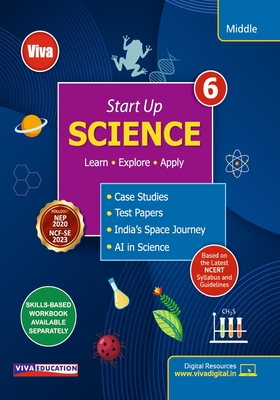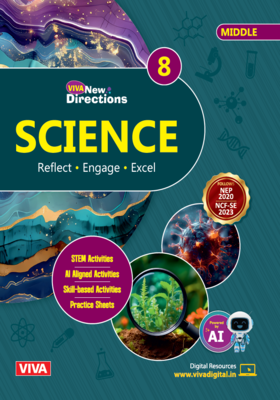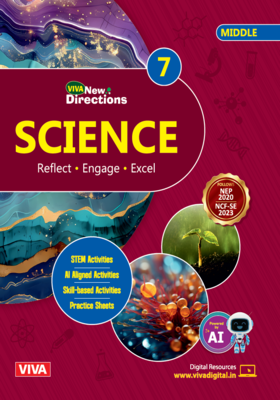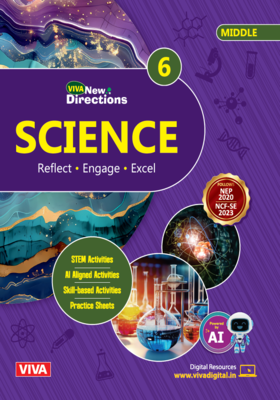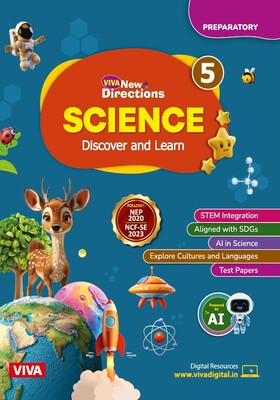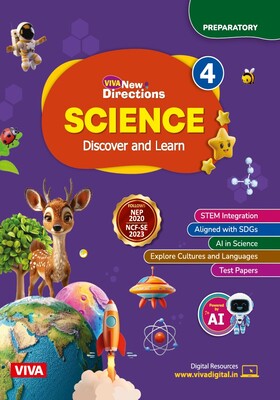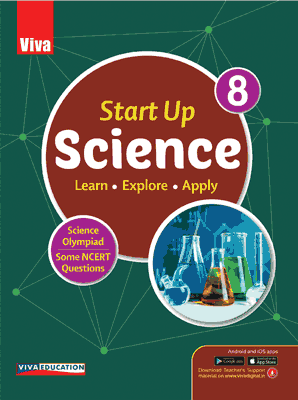
Viva Start Up Science, 8
Viva Start Up Science, 8
Learn • Explore• Apply (Science Olympiad, Selected NCERT Questions)
₹695.00
Go to cartISBN: 9789388386074
Bind: Paperback
Year: 2020
Pages: 316
Size: 8.5 x 11 Inch
Publisher: Viva Education
Exclusive Distributors: Viva Books
Sales Territory: Worldwide
Start Up Science for classes 6 to 8 exposes children to the vibrant nature and to the physical and chemical principles underlying various natural phenomena. The series is based on the principles of child-centered education, activity-based learning and holistic child development. It presents the subject matter in a carefully structured manner keeping in mind the vision of the National Curriculum Framework.
Key Features of Start Up Science 6 to 8
- Simple, easy to understand language and appropriately graded
- Margmments consisting of word meanings, Key Facts, Do You Know, Mind Scramblers and Classroom Discussions (containing questions based on Thinking Skills)
- In-text questions in Answer Orally
- A wide variety of exercises to assess the concepts learnt
- Ample number of tasks including activities and projects
- Sample test papers given to assess the knowledge of students
- Practice questions for Science Olympiad
Online Support Material:
- Printable Worksheets for Each Chapter
- Printable Practice Test Papers
- Answer Key
Online Support: www.vivadigital.in
Download Teacher's Support material on www.vivadigital.in
Download the Start Up Science app to enjoy the wholesome interactive learning experience
Also Available:
- Interactive Learning App
- Start Up Science Workbooks
- Detailed Teacher's Resource Material
- Start Up Science Lab Manuals
Target Audience:
Students of CBSE Class 8.
Contents:
Chapter 1: Crop Production • Crop Plants and Crop Seasons • Basic Practices of Crop Production • Food from Animals
Chapter 2: Microorganisms • Major Groups of Microorganisms • Where do Microorganisms Live• • Useful Microorganisms • Harmful Microorganisms • Food Preservation
Chapter 3: Synthetic Fibres and Plastics • Synthetic Fibres • Advantages and Disadvantages of Synthetic • Fibres • Plastics
Chapter 4: Metals and Non-Metals • Physical Properties of Metals • Physical Properties of Non-Metals • Chemical Properties of Metals • Chemical Properties of Non-Metals • Uses of Metals • Uses of Non-Metals
Practice Paper (Based On Chapters 1 to 4)
Chapter 5: Combustion and Flame • Combustion • Conditions Necessary for Combustion • Types of Combustion • Flame • Fuel • Principles of Extinguishing Fire
Chapter 6: Conservation of Biodiversity • Biodiversity • Causes of Loss of Biodiversity • Causes of Deforestation • Consequences of Deforestation • Recycling of Paper and Reforestation as Steps to Reduce Deforestation • Flora and Fauna • Endemic Species • Extinct and Endangered Species • Protected areas
Chapter 7: the Cell • Discovery of the Cell • Organization of Cells in Organisms • Cells in an Organism Vs Bricks in a Building • Variety in Cell Number, Shape and Size • Cell Structure and Function • Comparison of Plant and Animal Cells • Prokaryotic and Eukaryotic Cells
Chapter 8: Reproduction and adolescence • Modes of Reproduction • asexual Reproduction in animals • Sexual Reproduction in animals • Sexual Reproduction in Humans • Metamorphosis • Determination of Sex of the Baby • Hormones and Endocrine Glands • Adolescence and Puberty • Changes at Puberty • Secondary Sexual Characters • Role of Hormones in Metamorphosis in Insects and Frogs • Reproductive Phase of Life in Humans • Reproductive Health
Practice Paper (Based On Chapters 5 to 8)
Test Yourself (Based On Chapters 1 to 8)
Chapter 9: Force and Pressure • forces are Due to Interaction • Effects of force • Types of forces • Pressure
Chapter 10: Friction • Factors Affecting Friction • Types of Friction • Fluid Friction • advantages of Friction • Disadvantages of Friction • Increasing Friction • Reducing Friction
Chapter 11: Sound • Sound is Produced by a Vibrating Body • Sound Produced by Humans • Characteristics of Sound • Audible and Inaudible Sound • Noise and Music • Noise Pollution
Chapter 12: Chemical Effects of Current • Electric Current • Chemical Effects of Current • Application of Electrolysis
Practice Paper (Based On Chapters 9 to 12)
Chapter 13: Some Natural Phenomena • Electric Charges • Lightning • Earthquakes
Chapter 14: Light • Reflection of Light • Laws of Reflection • Characteristics of Image formed by a Plane Mirror • Regular and Diffused Reflection • How do We See Things • Multiple Images • Dispersion • Human Eye • Eyecare and Nutrition
Chapter 15: The Night • Sky • The Solar System • Stars
Chapter 16: Coal and Petroleum • Natural Resources • Fossil Fuels • Coal • Petroleum • Natural Gas • Energy Requirement • Problems of Overutilization • Natural Resources are Limited • Judicious Use of Energy • Conservation of Energy • Recycling of Paper
Chapter 17: Pollution of Air and Water • Pollution of Air • Pollution of Water • Potable Water • Case Studies
Practice Paper (Based On Chapters 13 to 17)
Test Yourself (Based On Chapters 9 to 17)
Practice Questions for Science Olympiad
Glossary
About the Authors:
Neha Sharma is a gold medalist in M.Tech. from Guru Gobind Singh lndraprastha University. She did her M.Sc. in Physics from University of Delhi and has worked as an Assistant Professor in Galgotias College of Engineering and Technology, Greater Noida for more than seven years. Presently she is working as PGT Physics in Venkateshwar Global School, Rohini.
Akanksha Dudpuri (M.Tech. in Biotechnology) is an educational books editor and a resource person based in New Delhi.
About the Series Editor:
Ajoy Ghatak has served as a Professor of Physics in IIT Delhi. He obtained his M.Sc. from the University of Delhi and Ph.D. from Cornell University. The awards he has received include the 2008 SPlE Educator Award, the 2003 Optical Society of America Esther Hoffman Beller Award, the CSlR S.S. Bhatnagar Award, the 16th Khwarizmi International Award, the International Commission for Optics Galileo Galilei Award and the Meghnad Saha Award for outstanding research contributions in theoretical sciences. He received a D.Sc. (Honoris Causa) from the University of Burdwan in 2007. Professor Ghatak has published numerous books in the areas of Optics, Quantum Mechanics and Fiber Optics and is a tireless promoter of science education worldwide.
